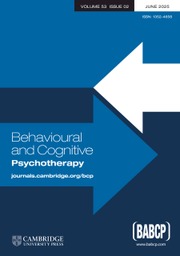Crossref Citations
This article has been cited by the following publications. This list is generated based on data provided by
Crossref.
Belvederi Murri, Martino
Respino, Matteo
Innamorati, Marco
Cervetti, Alice
Calcagno, Pietro
Pompili, Maurizio
Lamis, Dorian A.
Ghio, Lucio
and
Amore, Mario
2015.
Is good insight associated with depression among patients with schizophrenia? Systematic review and meta-analysis.
Schizophrenia Research,
Vol. 162,
Issue. 1-3,
p.
234.
Strauss, Clara
Thomas, Neil
and
Hayward, Mark
2015.
Can we respond mindfully to distressing voices? A systematic review of evidence for engagement, acceptability, effectiveness and mechanisms of change for mindfulness-based interventions for people distressed by hearing voices.
Frontiers in Psychology,
Vol. 6,
Issue. ,
GAUDIANO, BRANDON A.
BUSCH, ANDREW M.
WENZE, SUSAN J.
NOWLAN, KATHRYN
EPSTEIN-LUBOW, GARY
and
MILLER, IVAN W.
2015.
Acceptance-based Behavior Therapy for Depression With Psychosis.
Journal of Psychiatric Practice,
Vol. 21,
Issue. 5,
p.
320.
Schilbach, L.
Hoffstaedter, F.
Müller, V.
Cieslik, E.C.
Goya-Maldonado, R.
Trost, S.
Sorg, C.
Riedl, V.
Jardri, R.
Sommer, I.
Kogler, L.
Derntl, B.
Gruber, O.
and
Eickhoff, S.B.
2016.
Transdiagnostic commonalities and differences in resting state functional connectivity of the default mode network in schizophrenia and major depression.
NeuroImage: Clinical,
Vol. 10,
Issue. ,
p.
326.
Ricarte, J.J.
Ros, L.
Latorre, J.M.
and
Watkins, E.
2017.
Mapping autobiographical memory in schizophrenia: Clinical implications.
Clinical Psychology Review,
Vol. 51,
Issue. ,
p.
96.
Opoka, Sandra M.
and
Lincoln, Tania M.
2017.
The Effect of Cognitive Behavioral Interventions on Depression and Anxiety Symptoms in Patients with Schizophrenia Spectrum Disorders.
Psychiatric Clinics of North America,
Vol. 40,
Issue. 4,
p.
641.
Chiang, Yi-Hsuan
Beckstead, Jason W.
Lo, Su-Chen
and
Yang, Chiu-Yueh
2018.
Association of auditory hallucination and anxiety symptoms with depressive symptoms in patients with schizophrenia: A three-month follow-up.
Archives of Psychiatric Nursing,
Vol. 32,
Issue. 4,
p.
585.
Sellers, Rachel
Wells, Adrian
and
Morrison, Anthony P.
2018.
Are experiences of psychosis associated with unhelpful metacognitive coping strategies? A systematic review of the evidence.
Clinical Psychology & Psychotherapy,
Vol. 25,
Issue. 1,
p.
31.
Bartoskova, Magda
Sevcikova, Marcela
Durisko, Zachary
Maslej, Marta M.
Barbic, Skye P.
Preiss, Marek
and
Andrews, Paul W.
2018.
The form and function of depressive rumination.
Evolution and Human Behavior,
Vol. 39,
Issue. 3,
p.
277.
Lysaker, Paul H.
Pattison, Michelle L.
Leonhardt, Bethany L.
Phelps, Scott
and
Vohs, Jenifer L.
2018.
Insight in schizophrenia spectrum disorders: relationship with behavior, mood and perceived quality of life, underlying causes and emerging treatments.
World Psychiatry,
Vol. 17,
Issue. 1,
p.
12.
Luca, Maria
2019.
Maladaptive Rumination as a Transdiagnostic Mediator of Vulnerability and Outcome in Psychopathology.
Journal of Clinical Medicine,
Vol. 8,
Issue. 3,
p.
314.
Konsztowicz, Susanna
and
Lepage, Martin
2019.
The role of illness engulfment in the association between insight and depressive symptomatology in schizophrenia.
Journal of Psychiatric Research,
Vol. 111,
Issue. ,
p.
1.
Kim, Ji-Hyun
Piao, Yanhong
Kim, Woo-Sung
Park, Jeong-Jae
Kang, Nam-In
Lee, Keon-Hak
and
Chung, Young-Chul
2019.
The Development of the Brooding Scale.
Psychiatry Investigation,
Vol. 16,
Issue. 6,
p.
443.
Wang, Tzu‐Ting
Beckstead, Jason W.
and
Yang, Chiu‐Yueh
2019.
Social interaction skills and depressive symptoms in people diagnosed with schizophrenia: The mediating role of auditory hallucinations.
International Journal of Mental Health Nursing,
Vol. 28,
Issue. 6,
p.
1318.
Li, Wen
Yang, Yuan
An, Feng-Rong
Zhang, Ling
Ungvari, Gabor S.
Jackson, Todd
Yuan, Zhen
and
Xiang, Yu-Tao
2020.
Prevalence of comorbid depression in schizophrenia: A meta-analysis of observational studies.
Journal of Affective Disorders,
Vol. 273,
Issue. ,
p.
524.
Lee, Youngmin
Kang, Nam-In
Lee, Keon-Hak
Piao, YanHong
Cui, Yin
Kim, Sung-Wan
Lee, Bong Ju
Kim, Jung Jin
Yu, Je-Chun
Lee, Kyu Young
Won, Seung-Hee
Lee, Seung-Hwan
Kim, Seung-Hyun
Kang, Shi Hyun
Kim, Euitae
Kim, Saebom
and
Chung, Young-Chul
2020.
Effects of antipsychotics on rumination in patients with first-episode psychosis.
Progress in Neuro-Psychopharmacology and Biological Psychiatry,
Vol. 103,
Issue. ,
p.
109983.
Cui, Yin
Piao, YanHong
Kim, Sung-Wan
Lee, Bong Ju
Kim, Jung Jin
Yu, Je-Chun
Lee, Kyu Young
Won, Seung-Hee
Lee, Seung-Hwan
Kim, Seung-Hyun
Kang, Shi Hyun
Kim, Euitae
Kim, Namhee
and
Chung, Young-Chul
2020.
Psychological factors intervening between childhood trauma and suicidality in first-episode psychosis.
Psychiatry Research,
Vol. 293,
Issue. ,
p.
113465.
Chung, Young-Chul
Yun, Je-Yeon
Nguyen, Thong Ba
Rami, Fatima Zahra
Piao, Yan Hong
Li, Ling
Lee, Bomi
Kim, Woo-Sung
Sui, Jing
Kim, Sung-Wan
Lee, Bong Ju
Kim, Jung Jin
Yu, Je-Chun
Lee, Kyu Young
Won, Seung-Hee
Lee, Seung-Hwan
Kim, Seung-Hyun
Kang, Shi Hyun
and
Kim, Eui Tae
2021.
Network analysis of trauma in patients with early-stage psychosis.
Scientific Reports,
Vol. 11,
Issue. 1,
Chen, Yaopian
and
Li, Wei
2021.
Prevalence, Influencing Factors, and Cognitive Characteristics of Depressive Symptoms in Elderly Patients with Schizophrenia.
Neuropsychiatric Disease and Treatment,
Vol. Volume 17,
Issue. ,
p.
3645.
Novitskiy, M. A.
Shnayder, N. A.
and
Nasyrova, R. F.
2021.
The incidence of depressive disorders in patients with schizophrenia.
V.M. BEKHTEREV REVIEW OF PSYCHIATRY AND MEDICAL PSYCHOLOGY,
Vol. 56,
Issue. 3,
p.
45.



Comments
No Comments have been published for this article.